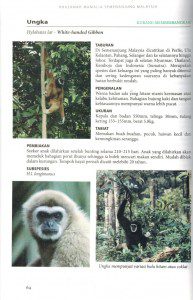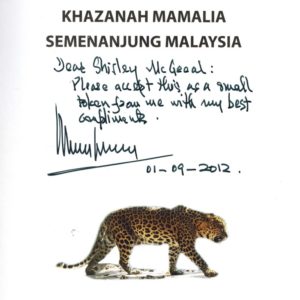Remembering teaming up with “Chief”


This book on the mammals of Malaysia, written by my dear friend Mohammed Khan, just came out.
I had a real surprise earlier this week when a package from Malaysia arrived in IPPL’s mail. It was a book I knew I’d never be able to read: a newly-published guide to Malaysia’s mammals—written in Bahasa Malaysia. However, I have been enjoying the photos of all the animals, especially the primates.
But what made the book’s arrival really important to me was that it was written by Mohammed Khan bin Momin Khan. He is the retired wildlife chief of Malaysia and one of the best friends I’ve ever made in my life of wildlife protection. Everyone calls him “Chief.” I remember his good looks and curly hair and his unforgettable smile.
I founded IPPL in 1973 when living in Bangkok. The wildlife trafficking in that part of the world was just appalling. Singapore in particular was a known hub for smuggling the region’s primates.
Malaysia was also plagued by wildlife traffickers, and I corresponded for a number of years with Mohammed Khan in his capacity as Director General of Malaysia’s Wildlife and National Parks Department, starting in 1975. He was keen to team up with me on smuggling cases, but we never met.

If you can read Bahasa Malaysia, you can learn a bit about white-handed gibbons!
In fact, in 1978, IPPL helped Chief Khan by exposing the source of funds for the establishment of proposed gibbon research laboratories in Malaysia. The U.S. National Cancer Institute (via Cambridge University) turned out to be behind this dreadful scheme.
Chief was furious—not least because certain documents uncovered by IPPL had named Mohammed Khan (much to his surprise) as a Malaysian official who would support the project. When Chief learned about this, he put a stop to the plans.
Then, in 1981, I was boarding a connecting flight while traveling from the United States to New Delhi for the Conference of the Parties to the Convention on International Trade in Endangered Species (CITES). As always, I had selected a window seat. To reach it, I had to pass the man in the aisle seat, and I nearly fell over him.

Here I am with Mohammed Khan in 1981, not long after we first met!
We said hello and began chatting. I described my IPPL activities to him, and the man (with a twinkle in his eye) told me that he didn’t like primates! Eventually, he let me know that he was my long-time pen-pal, Mohammed Khan. We laughed and laughed and have been friends ever since.
In 1983, he gave me the best present I could ever ask for. We were at another CITES conference, this time in Botswana. There, Chief asked me what I would like for my next birthday, and I told him: “An export ban on Malaysia’s monkeys!” He replied, “I’ll do it,” and, sure enough, the next year a ban went into effect. Despite efforts over the years to topple it, the legislation remains in place to this day.

A beautiful photo of a leaf monkey from Mohammed Khan’s book.
Even after this major victory, we continued to work together on behalf of Malaysia’s primates. In 1989, the notorious Danish wildlife smuggler Ingemar Forss moved to Malaysia and started circulating price-lists that offered orangutans, gibbons, proboscis monkeys, and many other wildlife species for sale.
Chief started looking into what was going on. IPPL got hold of some price-lists and provided them to Chief and to the Malaysian press, which covered the story. Forss, facing arrest, disappeared and never came back.
Sadly, Malaysian law compels government officials to retire at age 55, and Chief was forced to leave his post. Nobody as honest or dedicated has followed in his footsteps. In fact, he has continued working hard on wildlife protection during his “retirement,” including trying to save rhinos and elephants.

Chief’s kind inscription brought back many memories.
He inscribed his book to me, which he sent with his “best compliments.” I have so much to thank him for—and this book is a lovely reminder.

